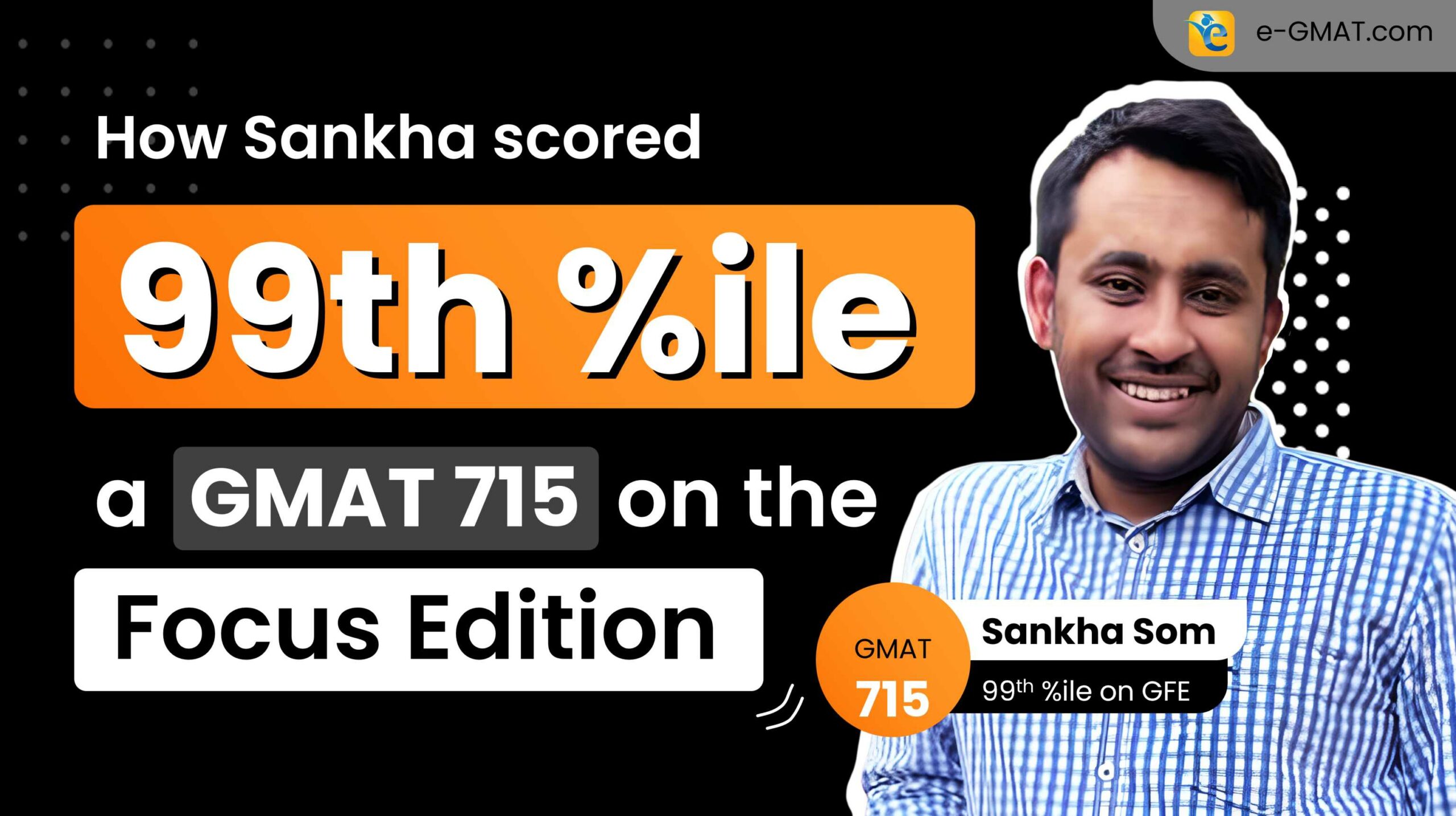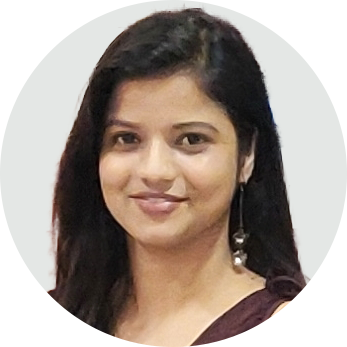When most GMAT aspirants achieve a strong score in one section, they often struggle to match it in the other. Sanjana’s journey stands out for breaking this pattern, achieving excellent in both sections with a Q87 and V85, including a remarkable 9-point improvement in Verbal.
Initial Challenges
Before her breakthrough, Sanjana’s approach to GMAT, particularly in Verbal, was creating more problems than solutions. Her Reading Comprehension strategy exemplified these inefficiencies.
“Before this, what I used to do was I used to read the passage, I used to jump into the question, then I go back to the passage and again come back with the options,” she recalls.
This back-and-forth approach was not only time-consuming but also prevented her from building a solid understanding of the passages.
In Critical Reasoning, the lack of a structured approach meant she was often led astray by answer choices rather than developing her own understanding first. The result was a V79 score that didn’t reflect her true potential.
Even in Quant, where she had a strong foundation, she found herself hitting a ceiling. The challenge wasn’t in the regular questions – it was specifically in those final few questions that separate good scores from great ones. As she puts it, “Those four to five questions in the end, which are brutal, will decide your destiny for cons.”

Her success stemmed from recognizing that excellence in both sections requires distinct but equally rigorous approaches. In Verbal, it was the adoption of structured pre-thinking strategies that transformed her approach. “When I was introduced to the pre-thinking approach through the course, I felt it very correct,” she explains. “My mind was convinced that this is the correct approach.”
Meanwhile, in Quant, she focused on mastering those crucial 4-5 challenging questions that determine elite scores. “It’s not about solving those 17 questions or 16 questions correctly,” she notes. “It’s actually about solving those 4-5 questions in the end, which are the hard questions.”
Meet Sanjana, who improved to 685
Transforming the Verbal Approach
The key to Sanjana’s dramatic verbal improvement lay in completely restructuring how she approached each question type. Her most significant breakthrough came in Reading Comprehension, where she abandoned the common but ineffective strategy of rushing through passages.
A glimpse at Sanjana’s Verbal Transformation
“Before taking e-GMAT, I just used to simply read the passage – I had no strategy,” she explains. “What I learned was to take those paragraph summaries – P1, P2, P3. For each passage, I would write a one-liner summary of those paragraphs.”
This methodical approach, combined with strict timing discipline, transformed her RC performance. She developed a clear framework: three minutes for shorter passages and four minutes for longer ones, with each subsequent question needing to be answered within one minute. As we can see in the below image – this forus-on approach allowed Sanjana to improve her accuracy in Humanities type RC passages from 66% to 82%!

In Critical Reasoning, she discovered that pre-thinking was the game-changer. “When I was introduced to the pre-thinking approach through the course, I felt it very correct,” she explains. “My mind was convinced that this is the correct approach.” Instead of jumping between answer choices, she learned to first analyze the argument’s structure and predict potential flaws. We can see in the below image, that Sanjana paid due diligence in internalizing the pre-thinking approach through the e-GMAT CR course.

This pre-thinking approach yielded multiple benefits: faster elimination of wrong answers, a clearer understanding of question logic, and increased accuracy – all contributing to her significant verbal score improvement.
This systematic approach to verbal yielded impressive results. Questions that once required multiple re-reads became manageable on the first attempt. Critical Reasoning problems that previously seemed confusing became structured exercises in logic. Most importantly, her confidence grew with each practice session, ultimately leading to that remarkable 9-point improvement from V79 to V85.
From Strong to Exceptional: The Quant Journey
While Sanjana was transforming her verbal performance, she faced a different challenge in Quant. Despite having a strong foundation, she found herself hitting a ceiling that many GMAT aspirants encounter – breaking past Q85.
How did Sanjana improve to Q87?
“It’s not about solving those 17 questions or 16 questions correctly,” Sanjana emphasizes. “It’s actually about solving those 4-5 questions in the end, which are hard questions… For doing those 4-5 hard questions correctly, you have to grind a lot.”
Her preparation took a targeted approach through two key strategies:
First, she used diagnostic quizzes to optimize her study time.
“PACE helped me save a lot of time because they had these diagnostic quizzes and they used to assess what topics I’m already good at,”
This strategic approach saved her an estimated 55-60 hours while ensuring she didn’t neglect any concepts.

Second, and perhaps more crucially, she embraced difficult questions during practice. Rather than avoiding challenging problems, she made them a cornerstone of her preparation. As we can see below – she excelled to upto 90% accuracy on hard question quizzes for number properties, thus ensuring her 90th percentile readiness.

“There are like some incredibly tough questions in Scholaranium… I think majority of the hard questions are those which you should practice because they develop your thinking ability.”
The effectiveness of this approach became clear on test day. Those supposedly “brutal” questions at the end? “I felt the last questions to be very easy,” she recalls. In fact, she was so comfortable with the difficult questions that she initially worried she must have made mistakes earlier in the section when she encountered seemingly straightforward problems near the end; a testament to how the right preparation strategy can transform even the most challenging questions into opportunities for scoring.
The Science of Strategic Practice: Quality Over Quantity
Achieving V85 and Q87 wasn’t just about knowing what to study – it was about how to practice effectively. Here, Sanjana discovered a counterintuitive truth about GMAT preparation: “Verbal is all about understanding first,” she explains. “It doesn’t matter if you solve 1000 questions or you solve 100 questions. If you’re solving 100 good questions and you understand all of them very thoroughly, then you don’t have to solve the 900 questions.”
This insight shaped her entire practice methodology. Rather than racing through questions, she focused on thorough understanding. “When I was solving, I used to make sure that even if I got an answer incorrect, I used to make sure I was doing the right kind of thinking. So next time I do not repeat that mistake.”
Sanjana discusses the importance of prioritizing quality practice over quantity:
Her practice sessions became focused laboratories for improvement, with each wrong answer serving as a learning opportunity. She actively engaged with the platform’s subject matter experts, challenging explanations when they weren’t clear and seeking deeper understanding. “There were some questions like I was challenging them and they were like explaining to me why this approach is incorrect and why this is correct.”

This methodical approach to practice paid off in both sections, contributing to her impressive 685 score. But perhaps more importantly, it revealed how getting questions right wasn’t enough – understanding why you got them right was crucial for consistent performance.
Test Day Execution: When Preparation Meets Pressure
The true test of preparation comes when facing unexpected challenges on test day. For Sanjana, this moment came early in her exam when she realized she had changed a correct answer to an incorrect one in Quant. At this crucial juncture, her preparation proved its worth.
How did Sanjana overcome test anxiety?
“Just a minute after that the verbal section had started,” she recalls. “The first question, obviously, it’s the CR question. And I was reading the line once, twice…” But rather than letting this spiral into panic, she took a deliberate pause.
“I had to take a moment. Just take a 10 seconds pause, close my eyes… whatever happened happened, I cannot do anything about it.”
This moment of composure proved pivotal. After taking those few seconds to reset, she engaged with the first verbal question, spending about three minutes to ensure she started the section on solid footing. From there, she found her rhythm and moved through the section with growing confidence.
The result spoke for itself: despite the early setback, she achieved an impressive V85, proving that test-day success is as much about mental resilience as it is about knowledge.
Key Learnings: Beyond the 685
The journey to a 685 with near-perfect sectional scores revealed insights that go beyond traditional GMAT wisdom. Drawing from her experience, Sanjana emphasizes three critical success factors that made the difference.
First, developing the right mindset toward practice. “It’s not about solving those 17 questions correctly,” she explains. “Having that mindset and strategy is very important. It’s not just about knowing the concept. It’s about how skillfully and how smartly and how effectively you are able to do it.”
Second, understanding that standardized test success isn’t linear. Mock scores may not always reflect your true progress. What matters is trusting in your preparation while maintaining the drive to improve. As she found, deep learning often manifests when it matters most – on test day.
Finally, the importance of structured thinking over memorization. Whether it was implementing pre-thinking in Verbal or tackling those final challenging Quant questions, success came from developing robust thought processes rather than relying on shortcuts.
Sanjana’s Final Advice for Test Takers:
SUCCESS BLUEPRINT
- Strategy Evolution:
- Process mastery over memorization
- Quality of practice over quantity
- Structured thinking in every section
- Focus on high-impact questions
For future GMAT aspirants, Sanjana’s journey from good scores to elite performance demonstrates that breaking through barriers requires more than just hard work – it requires smart work, strategic thinking, and unwavering trust in the process.
Are you planning to pursue MBA at top business schools? Let us help you conquer the first step of the process i.e., taking the GMAT. Take a free mock test to understand your baseline score and start your GMAT prep with our free trial. We are the most reviewed online GMAT Prep company with 2000+ five star reviews on GMATClub.















